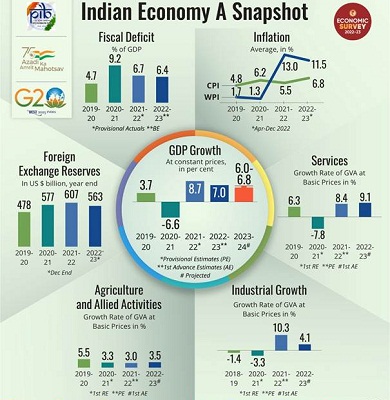Schedule a Call Back
Economic Survey: Indian economy is poised for faster growth in the coming decade
 Industry News
Industry News- Feb 01,23

New Delhi
India's economy is poised to grow faster in the coming decade, once the global shocks of the pandemic and Russian-Ukraine conflict fade away, stated the Economic Survey 2022-23 presented the Union Minister for Finance & Corporate Affairs, Nirmala Sitharaman, in Parliament yesterday.
Considering the evolving geo-political situation, the Survey notes that India has an opportunity to benefit from the diversification of global supply chains. The last few years have exposed multinational firms to unprecedented risks due to global trade tensions, pandemic-induced supply chain disruptions, and the conflict in Europe. With enabling policy frameworks, India presents itself as a credible destination for capital diversifying out of other countries. Thus, India’s growth outlook seems better than in the pre-pandemic years, and the Indian economy is prepared to grow at its potential in the medium term.
The Economic Survey notes that during 1998- 2002, transformative reforms were launched but yielded lagged growth dividends. This phenomenon was attributed to a series of one-off shocks resulting from external factors and the domestic financial sector clean-up, which overshadowed the growth returns from 1998 to 2002. By 2003, when the shocks dissipated, India participated in the global boom and grew at a higher rate. Similarly, in the present context, as the global shocks of the pandemic and the spike in commodity prices in 2022 fade away, the Indian economy is well placed to grow at its potential in the coming decade.
The Economic Survey states that the health and economic shocks of the pandemic and the spike in commodity prices in 2022 wear off, the Indian economy is thus well placed to grow at its potential in the coming decade, similar to the growth experience of the economy after 2003. The Economic Survey observes that with improved and healthier balance sheets of the banking, non-banking and corporate sectors, a fresh credit cycle has already begun, evident from the double-digit growth in bank credit over the past months. This is the primary reason for expecting India’s growth outlook to be better than it was in the pre-pandemic years.
The Survey further states that the digitalisation reforms and the resulting efficiency gains in terms of greater formalisation, higher financial inclusion, and more economic opportunities will be the second most important driver of India’s economic growth in the medium term. These productivity-enhancing reforms along with the Government's Skilling initiatives, will also help unleash the benefits of the demographic dividend in the coming years.
Promoting the private sector as a co-partner in the development
The Survey notes that a fundamental principle behind the government’s policy in the post-2014 period has been the engagement with the private sector as a partner in the development process. The New Public Sector Enterprise Policy for Aatmanirbhar Bharat has thus been introduced to realise higher efficiency gains by minimising the presence of the government in the PSEs to only a few strategic sectors. Significant initiatives have been introduced under Aatmanirbhar Bharat and Make in India programmes to enhance India’s manufacturing capabilities and exports across the industries. The National Logistics Policy (2022) has been launched to create an overarching logistics ecosystem for lowering the cost of logistics and bringing it to par with other developed countries. Liberalisation of FDI policy has resulted in a visible structural shift in the gross FDI flows to India during the last decade. Opening the strategic sectors, such as defence, mining and space, for the private sector has enhanced the business opportunities in the economy. Reforms to address the structural challenges faced by MSMEs have also been a vital part of the industrial policy in recent years.
The Economic Survey notes that a quantum leap in policy commitment and outlay for infrastructure is now visible in the last few years, cushioning economic growth when the non-financial corporate sector was unable to invest due to balance sheet troubles. In doing so, the government has laid a good platform for crowding in private investments and growth in the coming decade. Besides the push to physical infrastructure, the government’s emphasis on developing public digital infrastructure during the last few years has been a game changer in enhancing the economic potential of individuals and businesses. With its strong forward linkages to the non-digital sectors, digitalisation strengthens potential economic growth through various channels. Some of these, such as higher financial inclusion, greater formalisation, increased efficiencies and enhanced opportunities.
Related Stories

How trade wars and geopolitics are reshaping India’s growth story
India’s journey through the turbulence of trade wars and geopolitical conflicts is as much about resilience as it is about ambition. Rahul Bhandurge, Director - Sales & Business Development, BDB I..
Read more
The importance of project management to the Indian economy
Projects create assets, which are then used to produce goods and services, which then generate wealth. Time delays in projects not only lead to cost escalations, but also to delayed outputs, says R ..
Read more
Will revised MSME classification solve their funding puzzle?
Only 14 per cent of credit needs of Micro, Small and Medium Enterprises (MSMEs) - the backbone of India's economy - are met through formal channels. The revised MSME classification may mark a pivota..
Read more















